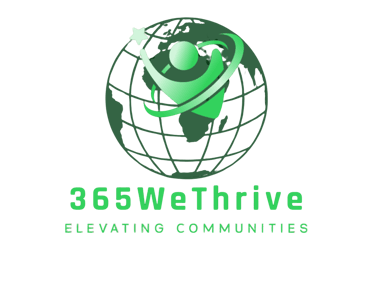submit interest for our programs and Events spaces are limited...
REGISTER FOR an experience that will last a lifetime! 365 Together we thrive!!
Breaking the Cycle of Poverty and Violence
This article highlights the root causes that contribute to the cycle of poverty and violence. It sheds light on why the cycle repeats itself and offers solutions.
Cassandra Olivier
9/30/20254 min read


The Blueprint for Peace: Transforming Trauma into Triumph
Let's be honest: seeing the headlines about violence in our neighborhoods is exhausting. It fills us with frustration, heartbreak, and a deep desire for change. It’s easy to feel like the problem is too big, too complex, or too ingrained to ever solve.
But what if we told you that we can minimize violence—not by adding more external force, but by building internal power?
At 365 We Thrive, we see violence not as an inevitability, but as the painful end result of broken systems. To truly build peace, we have to look past the symptoms and address the hidden blueprint of inequality that shapes too many young lives.
Unlocking the "Invisible Wiring" of Opportunity
The experts call them the Social Determinants of Health (SDoH), but we call them the "Invisible Wiring" of a community. These are the non-medical factors that influence health outcomes and the quality of life. They are the daily conditions that dictate whether a person lives with opportunity or oppression and constant risk. When this wiring is frayed, poverty and violence become entangled in a difficult cycle. The cycle continues to affect minority communities and settles in like plague. If people get an education or land a job, why does it still remain as an issues. Are we simply laying a bandaid on a blistering wound? What is going wrong? All but two of the basic SDoH are listed below; health care access/quality and social support network.
Here are three key areas where this failure to invest beyond a bandaid creates instability:
Economic Security: Imagine a job market where the only quick money is high-risk. When safe, legitimate pathways to wealth—like high-paying jobs or capital for a business idea—are inaccessible, the economic stability of a young person is zero. This desperation, sadly, increases the risk of crime simply as a matter of survival.
Quality Education & Skills: Education isn't just about diplomas; it's about agency. If the learning path doesn't teach modern, relevant skills (like digital design, financial modeling, or professional communication), the door to the middle class remains locked. This gap turns despair into chronic instability.
Environment & Mental Health: Constant exposure to trauma, gun violence, or unstable housing is not just sad; it's physically damaging. It floods the brain with stress hormones, making impulse control and clear decision-making incredibly difficult. When the environment is chaotic, the mind struggles to find peace, leading to conflict escalation.
The Vicious Cycle: When Instability Breeds Crisis
The painful truth is, economic hardship often serves as the perfect fuel for violence. It’s not about bad people; it’s about impossible choices dictated by a system of instability. It's the intersection of poverty and violence.
Think of it like this: When you’re living with chronic financial stress—the constant anxiety over rent, the hopelessness of stagnant wages—your body is in a permanent state of crisis. This stress doesn't just hurt your bank account; it takes a massive toll on your mind.
This relentless emotional and psychological burden means that a simple conflict that might be solved with a calm conversation in a secure place becomes explosive in an insecure one. These are the real-life accounts we see every day: the stress of poverty makes us reactive, shortens our fuse, and increases the chances that we will either engage in or become victims of violence. It’s a tragedy that compounds itself. The instability pushes opportunities away, ensuring the cycle continues, locking another generation into a difficult, high-risk path.
Our Big Question: Are We Still Using Band-Aids?
If traditional job training or generalized education were enough to break this, the problem would be solved. But too often, those efforts feel like applying a small patch to a gaping, infected wound. We focus on one piece—a new job or a health screening—but we don't fix the underlying "Invisible Wiring": the trauma, the lack of comprehensive financial control, and the deep disconnection that makes long-term success feel impossible.
To truly transform communities and minimize violence, we can’t just teach a single skill; we have to re-wire the entire blueprint for success. We need a framework that understands that a stable income is useless if unresolved trauma prevents you from keeping the job, and mental wellness is fragile if you can't afford rent.
This is exactly why 365 We Thrive created the ELEVATE & THRIVE model. It’s a holistic strategy that refuses to treat only the symptoms. We don’t just focus on one thing; we attack the root determinants of violence simultaneously to build pathways so solid, so comprehensive, that the path to violence loses its pull.
We developed this model around four core, integrated pillars. We start with Elevate Mindset (BeWell), which is all about brain science. We don't just talk about trauma; we teach emotional intelligence and the neuroscience of stress so youth can literally re-wire their reactions and choose thoughtful action over conflict. Once the mind is calm, we focus on wealth. Our Digital You! & Career Navigator (Career Explore) pillar tackles the lack of good jobs by giving them in-demand, tangible skills—from digital profile building to professional networking—creating legitimate economic pathways that are safer and more sustainable than high-risk alternatives. We then activate their potential through the Entrepreneur Launchpad (Incubator), teaching the "Science of Profit" and business fundamentals. This shifts them from feeling dependent to feeling like economic architects, giving them control over their financial future. Finally, through the Community Impact Lab (Project Community), we turn them into agents of change. They stop feeling like victims of their neighborhood and start gaining ownership over its success through civic engagement, increasing social cohesion and building lasting peace.
Join the Movement to Re-Wire Our Community
Building peace is not a quick fix; it’s an ongoing process of equipping our young people with the right tools. When a young person has a good job on the horizon, the ability to manage conflict, the capacity to make strategic decisions, and a sense of ownership over their community, the draw of violence fades.
We're already seeing incredible transformations. These pathways are working.
If you believe, as we do, that the most powerful form of violence prevention is not a single approach but a comprehensive solution packed with meaningful, achievable opportunity, mentorship and support resources, we invite you to connect with us. Share this vision, explore our programs, and become a part of the movement to re-wire the foundation of our neighborhoods—one future leader at a time. When we work as a collective, the goal of transforming trauma to triumph is attainable and sustainable.
365 Together We Thrive!
Elevate Youth
365 Together We Thrive !
Come along on the journey as we inspire youth leaders and shape communities that thrive.
365 We THrive NFP
THrive news
info@365wethriveinc.org
773-234-4456
© 2025. All rights reserved.
5113 S. Harper Ave
Chicago, IL 60615
365 We Thrive NFP is a 501(c)(3) charitable organization. Donations are tax-deductible to the extent allowed by law.
